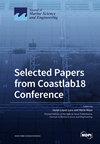开放海滩和内陷海滩对冬季条件的形态动力学响应:北大西洋伊比利亚海岸的两个案例研究
IF 2.7
3区 地球科学
Q1 ENGINEERING, MARINE
引用次数: 0
摘要
在 2018/19 年冬季,对伊比利亚西北部海岸不同海岸环境(内堤沙滩和开放沙滩)中的两个潮间带沙滩的形态响应进行了监测。近海波浪时间序列分析与高分辨率地形-测深测量相关联,以探索月度到季节尺度的时空形态变化。这两个地点都受到北大西洋波浪气候的影响,表现出明显的季节性。在过去十年(2010-2020 年)中,冬季的显著波高可达 Hs~9 米,夏季可达 Hs~6 米。该地区平均每年发生约 12 次风暴。研究结果清楚地表明,每个地点的上部海滩和潮间带在冬季的形态反应和沉积物迁移行为各不相同。在筑堤海滩(帕托斯),近岸的沉积物迁移受海滩护堤和水下沙洲之间的跨岸过程控制。与此相反,开放海滩(米拉)显示出动态的沉积物交换以及在堆积区和侵蚀区之间交替出现的三维形态。总体而言,冬季过后,两个海滩都呈现出侵蚀趋势,尤其是护堤侵蚀和海下沙滩体积/海岸线后退。这项研究强调了开阔海滩和淤积海滩在冬季条件下的形态动力反应对比,包括亚海面区和淹没区。当地的地质和环境因素,以及采用的海岸管理策略,都会影响海滩对冬季波浪事件的反 应。监测和了解这些反应,对于有效地进行海岸管理和适应不断变化的气候至关重要。本文章由计算机程序翻译,如有差异,请以英文原文为准。
Morphodynamic Response of Open and Embayed Beaches to Winter Conditions: Two Case Studies from the North Atlantic Iberian Coast
The morphological responses of two mesotidal beaches located in different coastal settings (embayed and open sandy beaches) on the northwestern Iberian coast were monitored during the winter of 2018/19. The offshore wave time series analysis is related to high-resolution topo-bathymetric measurements to explore spatial-temporal morphological variability at monthly to seasonal scales. Both locations are subjected to the North Atlantic wave climate which exhibits a pronounced seasonality. Throughout the last decade (2010–2020), significant wave heights reached values of up to Hs~9 m during winters and up to Hs~6 m during summers. On average, approximately 12 storms occurred annually in this region. The results clearly reveal divergent morphological responses and sediment transport behaviors at the upper beach and the intertidal zone during the winter for each location. In the embayed beach (Patos), sediment transport in the nearshore is governed by cross-shore processes between the beach berm and a submerged sandbar. In contrast, the open beach (Mira) showed dynamic sediment exchanges and three-dimensional morphologies alternating between accumulation and erosion zones. Overall, both beaches exhibited an erosional trend after the winter, particularly concerning berm erosion and the subaerial beach volume/shoreline retreat. This study highlights the contrasting morphodynamic response on open and embayed beaches to winter conditions, integrating both the subaerial and submerged zones. Local geological and environmental factors, as well as the coastal management strategies applied, will influence how the beach responds to winter wave events. Monitoring and understanding these responses are essential for effective coastal management and adaptation to changing climate.
求助全文
通过发布文献求助,成功后即可免费获取论文全文。
去求助
来源期刊

Journal of Marine Science and Engineering
Engineering-Ocean Engineering
CiteScore
4.40
自引率
20.70%
发文量
1640
审稿时长
18.09 days
期刊介绍:
Journal of Marine Science and Engineering (JMSE; ISSN 2077-1312) is an international, peer-reviewed open access journal which provides an advanced forum for studies related to marine science and engineering. It publishes reviews, research papers and communications. Our aim is to encourage scientists to publish their experimental and theoretical results in as much detail as possible. There is no restriction on the length of the papers. The full experimental details must be provided so that the results can be reproduced. Electronic files and software regarding the full details of the calculation or experimental procedure, if unable to be published in a normal way, can be deposited as supplementary electronic material.
 求助内容:
求助内容: 应助结果提醒方式:
应助结果提醒方式:


